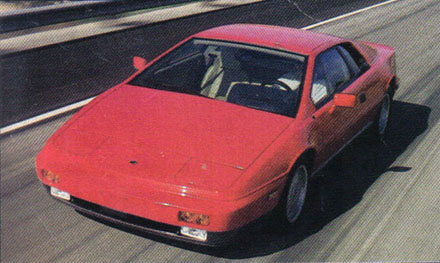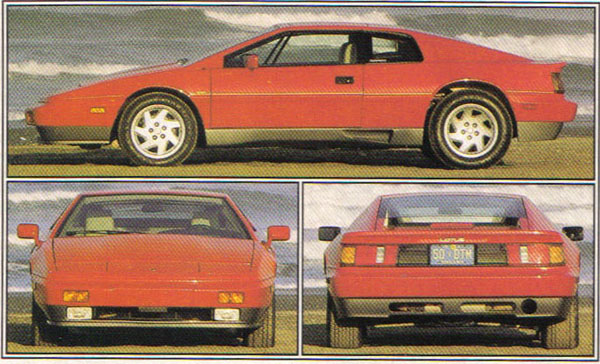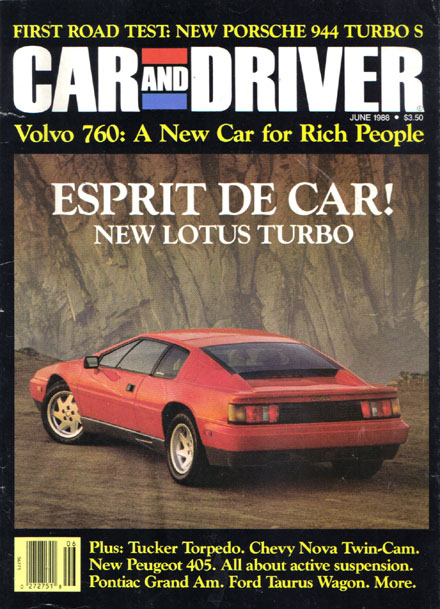
Car & Driver June 1988
Lotus
Esprit Turbo
It doesn't just want to go fast, it needs to
go fast.
BY ARTHUR ST. ANTOINE
At 120 mph the tiny engine is wound tight and the world beyond the windshield is hurtling by you in a violent blur and the wheel is quivering in your hands and the seat of your pants feels the urgent beat of the tar strips as you rocket over the narrow two-lane at two miles per minute, the engine note climbing, climbing and your view liquefying into a frenzied funnel of road and trees and sunlight and leaves and the flat, fiberglass projectile surrounding you going fast, faster, so fast you actually feel the speed. And then you shift into fifth.
Speed. It's the essence of the new Lotus Esprit Turbo. Admit it: you weren't lured to these pages by a desire to enrich your knowledge of drag coefficients or suspension settings or headlamp washers. You're here to read about speed, and we promise not to disappoint you. Twisted to the top of fifth gear, the new Esprit Turbo pulls all the way to 148 mph. From a standing start, it storms to 60 mph in 5 seconds and flashes through the quarter-mile lights in 14 seconds at 97 mph. If those numbers don't impress you (and they should), consider one additional fact: the Esprit Turbo achieves them with a 2.2liter four-cylinder engine. From 0 to 60 mph, the new Lotus is the quickest four cylinder-powered car available in the United States.
The 1988 Esprit Turbo, in fact, is one of the quickest cars in the U.S. of any kind. Consider a few comparisons. The V-8 powered Mustang GT accelerates from 0 to 60 in 6.3 seconds. The new Porsche 944 Turbo S hits 60 mph in 5.5 seconds. The automatic-equipped Corvette Z52 reaches 60 mph in 5.6 seconds and the quarter-mile in 14.3 seconds at 94 mph. Properly launched, the Esprit Turbo trounces them all. Only a handful of un-compromising speed machines-the Ferrari Testarossa, the Lamborghini Countach, and three of the most expensive Porsches can better the Esprit both from 0 to 60 and in the quarter-mile. Only a few more can match or exceed its terminal velocity. The new Lotus Esprit Turbo, in short, is a seriously fast car.
As you have already noticed, the new Esprit Turbo is also a seriously attractive car. More attractive than ever, we think, and that brings us to the big news this year. Though built on the same chassis as last year's car, the 1988 Esprit Turbo flaunts a stunning new exterior shape and a thoroughly revised cockpit. Please feel free to drool.
It took guts to tamper with Giugiaro's original Esprit design. If Lotus had spoiled the famous wedge-shaped sports car, introduced in 1975, it would have had to answer to such Esprit aficionados as James Bond. Fortunately, the factory in Hethel, England; appears to be safe from Q's lethal gadgets, for Lotus has pulled off the re-skin with flair and panache. (We're told that the updated edition doesn't drive underwater, but we bet 007 is pleased with it anyway.) Restyled completely in-house, the new Esprit Turbo is softer, sleeker, and more refined than the original. That it looks distinctly different is remarkable because, with its chassis unchanged, none of the car's dimensions could be significantly altered. Easily as provocative and attention grabbing as the original, the new Esprit Turbo is even sexier and more rakish. Except for the Lamborghini Countach and a few Ferraris, no other road car causes so much "Look at that!" rubber-necking.
The Esprit Turbo is also gorgeous on the inside. The old car drew criticism for its claustrophobic cockpit; the new car's cabin, though far from perfect, is noticeably better. Thanks to a reshaped transmission tunnel, there is more room for hips and thighs. At last, the seats offer rake adjustment, so trying to find a decent driving position is no longer an exercise in frustration. The dash has been redesigned, and many of the switches operate more easily and with better feel. New leather dash and door trim sets off the sumptuous Connolly-leather seats. A superb three-spoke, leather-wrapped steering wheel completes the luxurious but purposeful driving environment.
Opulent as it is, the Esprit's cabin still suffers from a number of shortcomings. The foot wells are so cramped that operating the pedals is like trying to play the piano with your toes. The thick steering wheel, which does not adjust, blocks the tops of some of the instruments unless you recline the seat as far back as possible. Surprisingly, the instrument layout still lacks an oil-temperature gauge. Worst of all is the crude climate-control panel. A build-it-yourself Heathkit version would look better and work more smoothly.
Underneath its slinky new body, the Esprit Turbo is completely unchanged. In the rumpus room, right behind the driver's head, sits the same turbocharged, sixteen-valve, 2.2-liter four-cylinder that powered last year's car. Fortified with Bosch K Jetronic fuel injection in 1986, the all-aluminum engine churns out 215 hp at 6250 rpm and 192 pound-feet of torque at 5000. Sleeker than ever, the 1988 Esprit Turbo makes the most of that power: its 148-mph top speed is 5 mph faster than the old car's (C&D, July 1986). Indeed, our 1988 test car probably would have gone even faster if not for its rev limiter, which inexplicably cut in before the engine could reach its 7000-rpm redline in top gear.
Fast as the Esprit Turbo is, dizzying velocity is only one of its talents. Lotuses are renowned for their handling prowess, and the new Esprit doesn't disappoint. Several staffers returned from Esprit afternoons with the same conclusion: the new Turbo thinks it's a single-seat racecar. Its steering response is go-kart quick, and hard cornering produces almost no body roll. It exhibits more understeer than we expected, but you can slide the tail out with a sudden move on or off the power. Shod with fat Goodyear NCT tires-195/6OVR-15s in front and 255/6OVR-15s in back-our test car circled the skidpad at a vein popping 0.86g, one of the highest such figures we have ever recorded. Despite its grip and its four disc brakes, though, our Esprit required 196 feet to stop from 70 mph. And, sadly, Lotus still does not offer anti-lock brakes. We think ABS should be standard on any car that so loves to be driven fast.
Scratch that: this car needs to be driven fast. The open road is the Esprit Turbo's element. Its steering, slow and heavy in traffic, becomes lighter and more precise at speed. Its wonderfully smooth engine, generally obedient but not happy around town, comes to life above 4000 rpm. Driving hard, you find the rhythm of the car. It begs to show you what it was designed to do. Before you know it you're snapping off shifts at 7000 rpm, squirting from corner to corner in explosive bursts of turbo-charged fury, and sailing through turns faster than you've ever dared. And you're grinning like a born-again fool. All of the race-car essentials are in evidence: the low-slung driving position, the ferocious engine, the stubby shifter, the narrow footwell, even the sky over your head if you remove the sunroof.
Driving an Esprit Turbo is the next-best thing to having your own Formula 1 machine.
Don't let our giddiness mislead you, however. We are not yet ready to cash in our pensions for an Esprit Turbo. Our test car squeaked and rattled over harsh pavement, the engine displayed a nasty tendency to stall at stoplights, and the rev limiter limited' our fun. We even had trouble getting into and out of the cocoonlike cockpit: Such annoyances do not make for all-out automotive lust.
And then there's the question of money a $64,000 question. Corvette owners will rightly assert that their steeds perform as well as the Esprit and are more comfortable at half the price. The Esprit Turbo, of course, isn't a rational car. It's a toy for those who can afford it; a racecar for country roads and weekend blasts. It's a stylish, potent exoticar for those who, unlike most of us, have the money to indulge in its undeni-able charms.
Lotus plans to sell only 400 Esprit Turbos in the U.S. this year, including 88 Commemorative Editions. That should be just enough to keep the well-heeled boy racers on our shores from embarrassing themselves by trying out for Formula l. The rest of us, if we're lucky, will catch an occasional glimpse.
COUNTERPOINT
It has been said only a madman would consider owning one of these expensive, cramped, ergonomically, deranged devices. If that's so, measure me for one of those canvas car coats with the extra-long sleeves that tie in the rear. The Lotus Esprit Turbo is fast, flashy, and fine. To feel it leap under your spur is to know what sudden speed was meant to be, but to look at its price is to suffer the degradation of fiscal self-pity.
There ought to be more room in the footwells, the instruments could be a bit more visible, and getting out of the car after the parking brake has been set could be a little less like trying to crawl out of a train wreck. And it costs $64,000!
The Lotus Esprit Turbo is, by any commonly accepted principles of reason and good sense, an expensive, impractical car. Cher or Madonna would be an expensive, impractical companion by those same stupid, petulant yardsticks. William Jeanes
The Lotus Esprit Turbo has all the elements that define an exotic sports car: an outrageous price tag, exclusivity, exhilarating performance, and, of course, numerous shortcomings. Given the engineering expertise at Lotus's disposal some of those shortcomings are difficult to accept.
If Lotus's suspension experts are smart enough to master active suspension, why does the Esprit pound so hard over small bumps? If Lotus has been building composite structures for nearly 30 years why does Esprit's chassis creak and groan so loudly? And if Lotus designers could rework the Esprit's skin so beautifully, why couldn’t they figure out how to keep the steering wheel from blocking the instruments or the engaged hand brake from barricading in the driver's feet?
State-of-the-art engineering and painstaking production development appears to be two different things. Csaba Csere
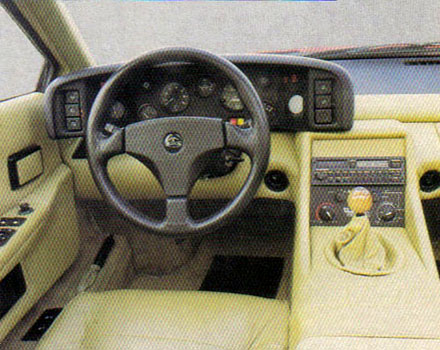
I didn't want to like the Esprit Turbo. Sure, it’s got a sensational body, but try comparing it with mass-produced cars of similar performance. A twelve-cylinder BMW 750i will go faster while providing limousine-like accommodations for four. A Corvette will almost hang with the Esprit Turbo in the critical go, stop, and turn contests, and it costs only half as much.
But then I spent the better part of a day behind the wheel, and the Esprit cast a spell over me. Every time I glanced at the speedo, I was in contempt of court. The tach needle always seemed to be at 7000 RPM. It was easy for the Walter Mitty in me to imagine that the Lotus F1 team had worked on the handling: the Esprit felt like a formula car. What can I say? Trying to be rational about a car like this is totally irrational.
And now a word to those few who can actually afford an Esprit: If you expect automotive perfection for your 60-odd grand, go buy a big German luxo-cruiser. But if you want a car that moves your soul as well as it moves your body, drop into the Lotus store. Rich Ceppos
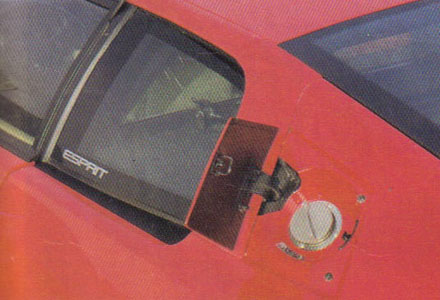
Lotus Branches Out
Some of its most satisfied customers aren’t buying sports cars. Mention Lotus to a car enthusiast and he'll think of Grand Prix racing and sports cars. Mention Lotus to a car engineer, however, and he is more likely to think of Lotus Engineering.
Lotus Engineering is not only the design and engineering arm of Group Lotus but also one of the fastest-growing consulting companies in the car business. It currently employs 500 people; mostly engineers, and their expertise is available to anyone who is willing to buy it. Their efforts so impressed General Motors that in 1986 GM bought all of Group Lotus, except far the Formula 1 team. Fortunately for other car companies, GM is an absentee landlord; Lotus Engineering is still free to work on a contract basis for all comers.
Lotus Engineering specializes in eight distinct areas. The broadest is car design and development. Show up with a bag of cash and a few sketches and the Lotus organization will quickly produce all the plans you'll need to put your car into production. The De Lorean was basically a Lotus Engineering design, as is the new Elan. which Lotus Cars should begin building soon, will be another.
Vehicle dynamics is probably the most renowned area of Lotus Engineering's expertise. Recently Isuzu hired Lotus to design a suspension that would improve the road manners of the Impulse, and it proudly advertises the connection. Other clients, including Toyota, have retained Lotus for similar reasons, but must have been unwilling to share the credit.
Active suspension promises to be the most significant outgrowth of Lotus's vehicle dynamics research. Developed for Grand Prix cars, this revolutionary technology is now being adapted to road vehicles (see following article). GM, Volvo, and behind the scenes, at least nine other carmakers are working with Lotus on active suspensions.
Lotus is also a pioneer in composite construction. For three decades, most Lotus road cars have had fiberglass bodies. In the mid-seventies, Lotus invented VARI (vacuum assisted resin injection), a process that, although largely automated, produces fiberglass as light and strong as the hand-laid composite. Today, in addition to the new Esprit, several boats and truck cabs have shells of VARI fiberglass.
Engines are another traditional Lotus strength. The first Elan, in 1963, had a twin-cam four-cylinder. The all-alumi-num, sixteen-valve four used in all cur-rent Lotuses was the first mass-produced four-valve-per-cylinder engine in modern automotive history. Lotus has designed a sixteen-valve version of Chrysler's ubiquitous 2.2-liter four, and figures prominently in the new 32-valve V8 that will power the upcoming King of the Hill Corvette.
Lotus's extensive four-cylinder experience has led to a novel approach to noise reduction. An experimental system called "adaptive noise control" uses microphones to monitor engine noise in a car's passenger compartment. A computer resolves the noise into its basic frequencies and uses the car's sound system to generate the same frequencies in reverse phase. The opposing sound waves cancel each other out resulting in a much quieter cabin. The system is still in the earliest stages of development, but it promises to be much more effective than conventional sound-deadening techniques.
Lotus Engineering is also working on multiplex wiring systems. Multiplex technology allows a single electrical circuit to control several functions, promising simpler and lighter wiring harnesses. To meet the needs of small-volume carmakers, Lotus is designing a multiplex system that is expected to require minimal manufacturer development.
In addition to its engineering activities, Lotus is moving into the styling arena. Its design group consists of only about half a dozen people, but they've done an excellent job of updating the Esprit. Achieving such a radical face-lift while meeting strict tooling limitations is often more difficult than designing new car on a clean sheet of paper.
Lotus Engineering's consulting work is critical to the survival of Lotus Cars. An automaker that produces fewer than a thousand cars a year can't afford to employ more than a handful of engineers; if not for its engineering arm, Lotus's product would still be nothing more than kit car's. Today's Lotuses, at last, are beginning to measure up to the quality of the big name exotics. As the marque moves steadily into Ferrari and Porsche territory, Lotus will need more than ever the refinement that only painstaking engineering development can provide. Csaba Csere
Thanks to Wayne Barratt for the article


